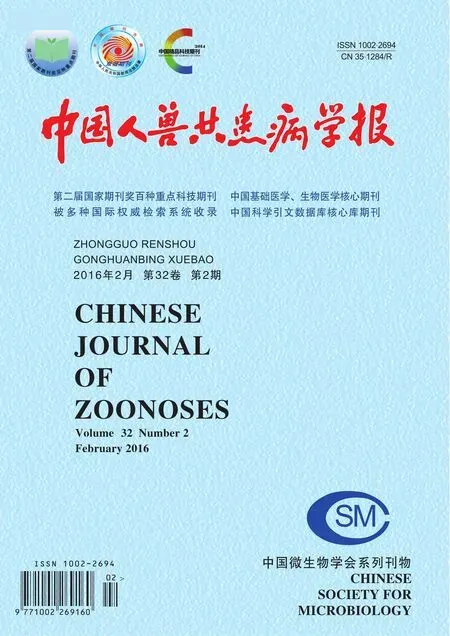不同CTX-M亚群鸡大肠杆菌毒力基因的流行特征
钟杏好,李进福,段沙沙,胡功政,苑 丽
不同CTX-M亚群鸡大肠杆菌毒力基因的流行特征
钟杏好,李进福,段沙沙,胡功政,苑丽
河南农业大学牧医工程学院,郑州450002
摘要:目的了解CTX-M-1亚群、CTX-M-9亚群与不产CTX-M3类鸡源大肠杆菌毒力基因的流行特征。方法从河南省不同地区分离获得CTX-M-1亚群鸡大肠杆菌33株,CTX-M-9亚群鸡大肠杆菌31株和不产CTX-M的鸡大肠杆菌23株,以多重PCR技术检测受试菌携带33种毒力基因的情况。结果3类受试菌毒力基因的携带种类趋于一致,其中feoB、fimH、traT和sitA在3类菌中检出率均较高。CTX-M-1亚群鸡大肠杆菌中traT和irp-2基因和CTX-M-9亚群鸡大肠杆菌中iroN、iss和irp-2基因的携带著高于不产CTX-M菌株。CTX-M-1亚群鸡大肠杆菌中cvaC和sfaS的携带率高于CTX-M-9亚群,而iroN和iss的携带率低于CTX-M-9亚群。结论结果表明CTX-M-1与CTX-M-9亚群大肠杆菌部分毒力基因的携带率明显高于不产CTX-M的菌株,CTX-M-9和CTX-M-1亚群鸡大肠杆菌携带的部分毒力基因差异明显,推测产CTX-M鸡大肠杆菌的致病力可能较强,且菌株的致病力可能还与其携带的CTX-M基因亚型有关。
关键词:鸡源大肠杆菌;CTX-M-1亚群;CTX-M-9亚群;毒力基因
产超广谱β-内酰胺酶(extended-spectrum β-lactamases, ESBLs)是肠杆菌科细菌对β-内酰胺类抗生素耐药最主要机制,其中大肠杆菌是ESBLs最主要的产生菌。ESBLs基因型众多,近十年来,CTX-M型已替代TEM型和SHV型成为散播最为广泛的基因型[1]。CTX-M型ESBLs主要包括6个亚群,其中CTX-M-1亚群和CTX-M-9亚群是世界各地最为常见的两个亚群[2]。
已经证实,大肠杆菌的致病力与其自身携带的多种毒力因子密切相关。Claudie Bonnet 等[3]认为ColV质粒+iss+tsh是禽致病性大肠杆菌的标志。Tetsuo Asai 等[4]证实与质粒相关的iutA、hlyF、iss、iroN 和ompT 这5个毒力基因与禽致病性大肠杆菌中的高致病力与耐药性显著相关[5-10 ]。
人们对产CTX-M大肠杆菌毒力基因的携带情况了解甚少。本研究拟对目前国内广泛散播的CTX-M-1亚群和CTX-M-9亚群的鸡大肠杆菌常见毒力基因进行检测,并与不产CTX-M鸡大肠杆菌的毒力基因比较分析,以期了解产CTX-M型鸡大肠杆菌的毒力基因流行特征及变化趋势。
1材料与方法
1.1菌株87株鸡大肠杆菌包括33株CTX-M-1亚群大肠杆菌,31株CTX-M-9亚群大肠杆菌和23株不产CTX-M大肠菌株,菌株为2013年1月至7月分离自河南省内不同地区具有典型鸡大肠杆菌病症状的患病鸡肝脏。
1.2毒力基因检测参考相关文献[11-14]合成33对毒力基因引物。33个毒力基因包括12个黏附素相关基因(bmaE、fimH、focG、iha、papA、papC、papGalleleⅠ、papGalleleⅡ、papGalleleⅢ、sfaS、gafD、和afa等),8个铁相关基因(feoB、fyuA、ireA、iroN、irp-2、iucC、iutA和sitA等),7个保护素基因(cvaC、iss、kpsMT(k1)、kpsMT Ⅱ、kpsMT Ⅲ、rfc和traT等),3个毒素基因(cdtB、hlyD和cnf-1),以及编码外膜蛋白的毒力基因ompT ,编码侵袭素的毒力基因ibeA和编码高致病性毒力岛的malX基因等。
1.3统计分析用SPSS 20.0 软件对3类鸡大肠杆菌携带的毒力基因进行χ2检验,比较三者之间毒力基因的差异。
2结果与分析
2.13类鸡大肠杆菌毒力基因的检测结果3类受试菌携带的毒力基因见表1。其中3类菌均不含bmaE、focG、iha、papA、papGalleleⅠ、papGalleleⅢ、gafD、afa、kpsMT Ⅲ、rfc、cdtB、hlyD、cnf-1和malX等14种毒力基因。

表1 3类菌毒力基因检测结果
Note: -, means not checked out
由表1可知,受试菌携带与铁吸收和转运相关的毒力基因数量及种类最多,8个铁相关基因均有检出。在12种与菌株黏附素有关的毒力基因中,仅检出4种,其中仅CTX-M-1亚群鸡大肠杆菌检出sfaS基因,同时除fimH基因检出率较高外,其他黏附素相关基因的检出率均较低,说明fimH基因在鸡大肠杆菌黏附过程中可能发挥了主导作用。在7个保护素毒力基因中,traT基因检出率最高,所有受试菌均未检出kpsMT Ⅲ和rfc基因。此外,所有菌株均未检出编码细菌毒素的三种毒力基因。
同时由表还可以看出,3类受试菌毒力基因的携带种类趋于一致,其中feoB在3类菌中检出率最高,均100%被检出,在3类菌中检出率较高的还有fimH、traT和sitA基因。
2.23类鸡大肠杆菌毒力基因的差异分析3类受试菌毒力基因之间的χ2检验结果见表2。

表2 3类大肠杆菌毒力基因卡方检验分析结果
Note: *, significant difference; **, very significant difference; -, means no result
由表1和表2知,在CTX-M-1亚群鸡大肠杆菌中,traT和irp-2基因的携带率均显著高于不产CTX-M的鸡大肠杆菌,且irp-2基因的携带率高于不产CTX-M的鸡大肠杆菌;在CTX-M-9亚群鸡大肠杆菌中,iroN、iss和irp-2基因的携带率也高于不产CTX-M的鸡大肠杆菌,其中iss基因在两者之间的差异有统计学意义。在33株CTX-M-1菌和31株CTX-M-9菌中,iroN、iss、cvaC和sfaS 4种毒力基因的携带率差异显著,其中cvaC和sfaS基因在CTX-M-1菌中的携带率较高,而iroN和iss基因在CTX-M-1菌中携带率却较低。
3讨论
本试验结果显示CTX-M-1亚群菌株与CTX-M-9亚群菌株的irp-2基因携带率均高于不产CTX-M的菌株,而在CTX-M-9亚群鸡大肠杆菌中,iroN和iss基因的携带率显著高于CTX-M-1亚群和不产CTX-M的菌株。iroN基因和irp-2基因为参与细菌体内铁吸收和转运相关基因,参与细菌体内铁离子的吸收和转运,而铁离子是细菌在生长繁殖过程中必需的离子之一,如吸收或转运障碍,细菌就不能正常的生长繁殖。其中,irp-2可作为耶尔森氏菌强毒力岛的检测标志,张艳英等研究发现在腹泻病死貉脏器以及粪便中分离出的大肠杆菌致病力较强且均含有irp-2[15]。Luo等认为铁相关基因在导致泌尿系统反复感染过程中发挥了至关重要的作用[16]。iss基因参与编码外膜蛋白,与细菌抗补体作用有关,可增强大肠杆菌的血清抗性, 从而有助于菌株在宿主体内进行快速增殖[17]。
traT基因编码与血清抵抗相关的外膜蛋白,是尿道致病性大肠杆菌中检出率最高的毒力基因之一[18-19],与大肠杆菌导致的泌尿道感染密切相关,Firoozeh等认为traT基因可作为治疗大肠杆菌病靶基因[19]。本试验在3类不同的大肠杆菌中均检出了traT基因,3类菌携带率介于56.5%~84.8%,其中CTX-M菌株的携带率均高于不产CTX-M菌株。至于traT基因在产CTX-M菌株中携带率升高能否确实导致该类菌致病力增强还尚须进一步研究证实。
本试验共设计了12种与菌株黏附素有关毒力基因的相关引物,但经PCR检测仅检出fimH、sfaS、papC和papGalleleⅡ 4种基因。fimH基因在3类菌中的检出率均较高,检出率介于87.1%~91.3%,与文献报道类似[20],且3类菌之间差异不显著。已经证实,I型菌毛是尿道致病性大肠杆菌重要的粘附毒力因子,它的表达与大肠杆菌在宿主体内定植和致病性密切相关。I型菌毛由fim基因簇编码,其中fimH基因编码的fimH 粘附蛋白位于I型菌毛顶端,是介导大肠杆菌与易感宿主细胞发生特异性黏附的最主要的粘附分子。sfaS基因仅在CTX-M-1亚群菌株中检出,sfaS基因编码S纤毛,是另一个在细菌粘附过程中发挥重要作用的粘附因子,其能促进菌株在宿主体内扩散并导致败血症、脑膜炎及泌尿系统感染等[21-22]。
参考文献:
[1]Zhao WD, Yan P, Guan HN, et al. Characterization of CTX-M-type extended-spectrum beta-lactamase in clinical clones ofEscherichiacoliin Southwest China[J]. J Basic Microbiol, 2014, 54(3): 247-252. DOI:10.1002/jobm.201200313
[2]Livermore DM, Canton R, Gniadkowski M, et al. CTX-M: changing the face of ESBLs in Europe[J]. J Antimicrob Chemother, 2007, 59(2): 165-174. DOI: 10.1093/jac/dkl483
[3]Bonnet C, Diarrassouba F, Brousseau R, et al. Pathotype and antibiotic resistance gene distributions ofEscherichiacoliisolates from broiler chickens raised on antimicrobial-supplemented diets[J]. Appl Environ Microbiol, 2009, 75(22): 6955-6962. DOI: 10.1128/AEM.00375-09
[4]Asai T, Masani K, Sato C, et al. Phylogenetic groups and cephalosporin resistance genes ofEscherichiacolifrom diseased food-producing animals in Japan[J]. Acta Vet Scand, 2011, 53: 52. DOI: 10.1186/1751-0147-53-52
[5]Bristianou M, Panagou C, Adamis T, et al. The impact of multidrug resistance on the pathogenicity ofEscherichiacoli: an experimental study[J]. Int J Antimicrob Agents, 2008, 31: 216-223. DOI:10.1016/j.ijantimicag
[6]Piatti G, Mannini A, Balistreri M, et al. Virulence factors in urinaryEscherichiacolistrains: phylogenetic background and quinolone and fluoroquinolone resistance[J]. J Clin Microbiol, 2008, 46(2): 480-487. DOI:10.1128/JCM.01488-07
[7]Takahashi A, Muratani T, Yasuda M, et al. Genetic profiles of fluoroquinolone-resistantEscherichiacoliisolates obtained from patients with cystitis: phylogeny, virulence factors, PAIusp subtypes, and mutation patterns[J]. J Clin Microbiol, 2009, 47(3): 791-795. DOI: 10.1128/JCM.01740-08
[8]Khatib R, Jose J, Musta A, et al. Relevance of vancomycin-intermediate susceptibility and heteroresistance in methicillin- resistantStaphylococcusaureusbacteraemia[J]. J Antimicrob Chemother, 2011, 66(4): 1594-1599. DOI: 10.1093/jac/dkr169
[9]Jadhav S, Hussain A, Devi S, et al. Virulence characteristics and genetic affinities of multiple drug resistant uropathogenicEscherichiacolifrom a semi urban locality in India[J]. PLoS One, 2011, 6(3): 1-7. DOI:10.1371/journal.pone.0018063
[10]Park KH, Kim ES, Kim HS, et al. Comparison of the clinical features, bacterial genotypes and outcomes of patients with bacteraemia due to heteroresistant vancomycin-intermediateStaphylococcusaureusand vancomycin-susceptibleS.aureus[J]. J Antimicrob Chemother, 2012, 67(4): 1843-1849. DOI:10.1093/jac/dks131
[11]Lavigne JP, Blanc-Potard AB, Bourg G, et al. Virulence genotype and nematode-killing properties of extra-intestinalEscherichiacoliproducing CTX-M β-lactamases[J]. Clin Microbiol Infect, 2006, 12(12): 1199-1206. DOI:10.1111/j.1469-0691.2006.01536.x
[12]Van der Bij AK, Peirano G, Pitondo-Silva A, et al. The presence of genes encoding for different virulence factors in clonally relatedEscherichiacolithat produce CTX-Ms[J]. Diagn Microbiol Infect Dis, 2012, 72(4): 297-302. DOI: 10.1016/j.diagmicrobio.2011.12.011
[13]Rodriguez-Siek KE, Giddings CW, Doetkott C, et al. Comparison ofEscherichiacoliisolates implicated in human urinary tract infection and avian colibacillosis[J]. Microbiology, 2005, 151: 2097-2110. DOI:10.1099/mic.0.27499-0
[14]Zhao LX, Chen X, Xu XJ, et al. Analysis of the AIDA-I gene sequence and prevalence inEscherichiacoliisolates from pigs with post-weaning diarrhoea and oedema disease[J]. Vet J, 2009, 180(1): 124-129. DOI: 10.1016/j.tvjl.2007.10.021
[15]Zhang YY, Shi QM, Fang H, et al. Detection on pathogenicity islands ofYersiniaenterocoliticaHPI fromEscherichiacolistrains in diarrheic young raccoon dogs[J]. Chin J Zoonoses, 2012, 28(2): 179-182. (in Chinese)
张艳英, 史秋梅, 房海,等. 腹泻仔貉检出携带耶尔森菌HPI毒力岛的大肠杆菌[J]. 中国人兽共患病学报, 2012, 28(2): 179-182.
[16]Luo Y, Ma Y, Zhao Q, et al. Similarity and divergence of phylogenies, antimicrobial susceptibilities, and virulence factor profiles ofEscherichiacoliisolates causing recurrent urinary tract infections that persist or result from reinfection[J].J Clin Microbiol, 2012, 50(12): 4002-4007. DOI: 10.1128/JCM.02086-12
[17]Johnson TJ, Wannemuehler YM, Nolan LK, et al. Evolution of theissgene inEscherichiacoli[J]. Appl Environ Microbiol, 2008, 74(8): 2360-2369. DOI: 10.1128/AEM.02634-07
[18]Oliverira FA, Paludo KS, Arend LN, et al. Virulence characteristics and antimicrobial susceptibility of uropathogenicEscherichiacolistrains[J]. Genet Mol Res, 2011, 10: 4114-4125. DOI: 10.4238/2011.October.31.5
[19]Firoozeh F, Saffari M, Neamati F, et al. Detection of virulence genes inEscherichiacoliisolated from patients with cystitis and pyelonephritis[J]. Inter J Infect Dis, 2014, 29: 219-222. DOI: 10.1016/j.ijid.2014.03.1393
[20]Wang Y, Liu MD. Examination of fimH gene ofE.colistrains and the homology analysis ofE.colistrains for patients with urinary tract infections[J]. J Tian’jin Med Univ, 2014, 20(1): 45-47. (in Chinese)
王悦, 刘德梦. 泌尿系感染患者大肠埃希菌fimH基因检测及尿便来源菌株同源性分析[J]. 天津医科大学学报, 2014, 20(1): 45-47.
[21]Pobiega M, Wojkowska-Mach J, Chmielarczyk A, et al. Molecular characterization and drug resistance ofEscherichiacolistrains isolated from urine from long-term care facility residents in Cracow, Poland[J].Med Sci Monit, 2013, 19: 317-326. DOI: 10.12659/MSM.883898
[22]Bien J, Sokolova O, Bozko P. Role of uropathogenicEscherichiacolivirulence factors in development of urinary tract infection and kidney damage[J]. Int J Nephrol, 2012: 681473. DOI: 10.1155/2012/681473
DOI:10.3969/j.issn.1002-2694.2016.02.010
通讯作者:苑丽, Email:yuanli-hn@163.com
Corresponding author:Yuan li, Email: yuanli-hn@163.com
中图分类号:R378
文献标识码:A
文章编号:1002-2694(2016)02-0152-04
收稿日期:2015-08-16;修回日期:2015-11-20
Characteristic of virulence genes among CTX-M clusters Escherichia coli isolates from chicken
ZHONG Xing-hao,LI Jin-fu,DUAN Sha-sha,HU Gong-zheng,YUAN Li
(College of Animal Science and Veterinary Medicine, Henan Agricultural University, Zhengzhou 450002, China)
Abstract:This research was conducted to explore the epidemiologies of the virulence genes in CTX-M-1 cluster Escherichia coli, CTX-M-9 cluster isolates and non-CTX-M ones by multiplex-PCR. The strains, including 33 CTX-M-1 Escherichia coli isolates, 31 CTX-M-9 isolates and 23 non-CTX-M ones, were isolated from chickens in Henan Province. The results showed that all of E. coli contained almost similar virulence genes and the detection rates of feoB, fimH, traT, and sitA were higher than the others. The CTX-M-1 cluster and the CTX-M-9 cluster E. coli harbored significantly more virulence factors than non-CTX-M isolates, with the traT and irp-2 in the CTX-M-1 cluster and the iron, iss and irp-2 in CTX-M-9 cluster. Moreover, the partial virulence factors showed significantly difference between the CTX-M-1 cluster and the CTX-M-9 cluster. The cvaC and sfaS genes in the former were significantly more than those in the latter, but the iroN and iss genes were significantly fewer. In conclusion, the pathogenicities of CTX-M-producing E. coli maybe more powerful, and the CTX-M genotypes maybe had close relationship with their pathogenicity.
Keywords:E. coli isolates from chickens; CTX-M-1 cluster; CTX-M-9 cluster; virulence genes
国家自然科学基金项目(No.31201965)资助
Supported by the National Natural Science Foundation of China (No. 31201965)

